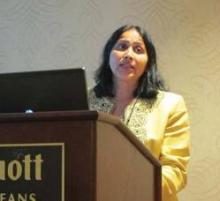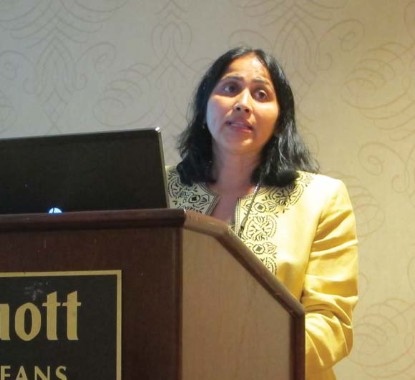User login
Washington University School of Medicine in St. Louis has led the charge for pediatric hospitalist sedation, offering a panel of experts who shared their insights on nitrous oxide sedation in a wide-ranging, hands-on session at Pediatric Hospital Medicine 2013. Some highlights of that session were:
• Administer 50%-70% nitrous oxide (N2O) based on the need for minimal, moderate, or deep sedation. Consider N2O alone for procedures such as joint injections or voiding cystourethrograms.
• Augment N2O with 0.15-0.3 mg/kg of oxycodone (maximum dose of 10 mg) to achieve deeper sedation and greater analgesia for more painful procedures such as abscess incision and drainage, burn debridement, and postoperative dressing change. To maximize the analgesic effect of the opioid, wait for its effect to peak at 60 minutes before administering N2O.
• The peak effect of N2O is usually seen within 2-3 minutes, so plan to perform the most painful portion of the procedure at least 2 minutes after the start of 70% N2O. Titrate to 50% after about 5 minutes of 70% N2O, with a total duration of N2O not to exceed 15 minutes.
• Be alert for signs of emesis during sedation such as pallor, sweating, and elevation in heart rate, and position the patients appropriately so they do not aspirate, if there is emesis.
• The hospitalists’ only duty is to perform the sedation, but monitoring should be performed by qualified personnel according to American Academy of Pediatrics, American Society of Anesthesiologists, and local institutional guidelines. At St. Louis Children’s Hospital, a trained sedation nurse is present during and after sedation. Rescue equipment including continuous positive airway pressure (CPAP) bag, and suction and airway supplies should be readily available, if needed.
• Administer 100% oxygen for 2-3 minutes after turning off the N2O to prevent diffusion hypoxia and improve scavenging of exhaled N2O and, thus, reduce the environmental N2O exposure to sedation providers, nursing staff, and family members.
• Ensure that scavenging systems and proper airflow parameters are in place for rooms that use N2O to reduce N2O exposure. Use passive air monitoring badges to measure exposure and avoid exposing pregnant health care workers and family members by using good delivery techniques.
• Contraindications to N2O sedation include, but are not limited to patients with any trapped air in a body cavity, such as those with bowel obstruction, recent tympanoplasty, or recent intraocular surgery; patients with elevated intracranial pressure; and those with a deficiency in vitamin B12 or the enzyme 5, 10 methylenetetrahydrofolate reductase. Caution should be used in sickle cell patients, although gastroesophageal reflux disease is not a contraindication.
It has been noted that there have been reports of infertility, blood dyscrasias, and neurologic deficits with chronic exposure to nitrous oxide exposure. However, N2O has been used safely in dental offices and OR suites for several decades.
The Washington University team included Dr. Mythili Srinivasan, Dr. Jon Chiles, Dr. Mike Turmelle, and Dr. Yasmeen Daud.
Washington University School of Medicine in St. Louis has led the charge for pediatric hospitalist sedation, offering a panel of experts who shared their insights on nitrous oxide sedation in a wide-ranging, hands-on session at Pediatric Hospital Medicine 2013. Some highlights of that session were:
• Administer 50%-70% nitrous oxide (N2O) based on the need for minimal, moderate, or deep sedation. Consider N2O alone for procedures such as joint injections or voiding cystourethrograms.
• Augment N2O with 0.15-0.3 mg/kg of oxycodone (maximum dose of 10 mg) to achieve deeper sedation and greater analgesia for more painful procedures such as abscess incision and drainage, burn debridement, and postoperative dressing change. To maximize the analgesic effect of the opioid, wait for its effect to peak at 60 minutes before administering N2O.
• The peak effect of N2O is usually seen within 2-3 minutes, so plan to perform the most painful portion of the procedure at least 2 minutes after the start of 70% N2O. Titrate to 50% after about 5 minutes of 70% N2O, with a total duration of N2O not to exceed 15 minutes.
• Be alert for signs of emesis during sedation such as pallor, sweating, and elevation in heart rate, and position the patients appropriately so they do not aspirate, if there is emesis.
• The hospitalists’ only duty is to perform the sedation, but monitoring should be performed by qualified personnel according to American Academy of Pediatrics, American Society of Anesthesiologists, and local institutional guidelines. At St. Louis Children’s Hospital, a trained sedation nurse is present during and after sedation. Rescue equipment including continuous positive airway pressure (CPAP) bag, and suction and airway supplies should be readily available, if needed.
• Administer 100% oxygen for 2-3 minutes after turning off the N2O to prevent diffusion hypoxia and improve scavenging of exhaled N2O and, thus, reduce the environmental N2O exposure to sedation providers, nursing staff, and family members.
• Ensure that scavenging systems and proper airflow parameters are in place for rooms that use N2O to reduce N2O exposure. Use passive air monitoring badges to measure exposure and avoid exposing pregnant health care workers and family members by using good delivery techniques.
• Contraindications to N2O sedation include, but are not limited to patients with any trapped air in a body cavity, such as those with bowel obstruction, recent tympanoplasty, or recent intraocular surgery; patients with elevated intracranial pressure; and those with a deficiency in vitamin B12 or the enzyme 5, 10 methylenetetrahydrofolate reductase. Caution should be used in sickle cell patients, although gastroesophageal reflux disease is not a contraindication.
It has been noted that there have been reports of infertility, blood dyscrasias, and neurologic deficits with chronic exposure to nitrous oxide exposure. However, N2O has been used safely in dental offices and OR suites for several decades.
The Washington University team included Dr. Mythili Srinivasan, Dr. Jon Chiles, Dr. Mike Turmelle, and Dr. Yasmeen Daud.
Washington University School of Medicine in St. Louis has led the charge for pediatric hospitalist sedation, offering a panel of experts who shared their insights on nitrous oxide sedation in a wide-ranging, hands-on session at Pediatric Hospital Medicine 2013. Some highlights of that session were:
• Administer 50%-70% nitrous oxide (N2O) based on the need for minimal, moderate, or deep sedation. Consider N2O alone for procedures such as joint injections or voiding cystourethrograms.
• Augment N2O with 0.15-0.3 mg/kg of oxycodone (maximum dose of 10 mg) to achieve deeper sedation and greater analgesia for more painful procedures such as abscess incision and drainage, burn debridement, and postoperative dressing change. To maximize the analgesic effect of the opioid, wait for its effect to peak at 60 minutes before administering N2O.
• The peak effect of N2O is usually seen within 2-3 minutes, so plan to perform the most painful portion of the procedure at least 2 minutes after the start of 70% N2O. Titrate to 50% after about 5 minutes of 70% N2O, with a total duration of N2O not to exceed 15 minutes.
• Be alert for signs of emesis during sedation such as pallor, sweating, and elevation in heart rate, and position the patients appropriately so they do not aspirate, if there is emesis.
• The hospitalists’ only duty is to perform the sedation, but monitoring should be performed by qualified personnel according to American Academy of Pediatrics, American Society of Anesthesiologists, and local institutional guidelines. At St. Louis Children’s Hospital, a trained sedation nurse is present during and after sedation. Rescue equipment including continuous positive airway pressure (CPAP) bag, and suction and airway supplies should be readily available, if needed.
• Administer 100% oxygen for 2-3 minutes after turning off the N2O to prevent diffusion hypoxia and improve scavenging of exhaled N2O and, thus, reduce the environmental N2O exposure to sedation providers, nursing staff, and family members.
• Ensure that scavenging systems and proper airflow parameters are in place for rooms that use N2O to reduce N2O exposure. Use passive air monitoring badges to measure exposure and avoid exposing pregnant health care workers and family members by using good delivery techniques.
• Contraindications to N2O sedation include, but are not limited to patients with any trapped air in a body cavity, such as those with bowel obstruction, recent tympanoplasty, or recent intraocular surgery; patients with elevated intracranial pressure; and those with a deficiency in vitamin B12 or the enzyme 5, 10 methylenetetrahydrofolate reductase. Caution should be used in sickle cell patients, although gastroesophageal reflux disease is not a contraindication.
It has been noted that there have been reports of infertility, blood dyscrasias, and neurologic deficits with chronic exposure to nitrous oxide exposure. However, N2O has been used safely in dental offices and OR suites for several decades.
The Washington University team included Dr. Mythili Srinivasan, Dr. Jon Chiles, Dr. Mike Turmelle, and Dr. Yasmeen Daud.


